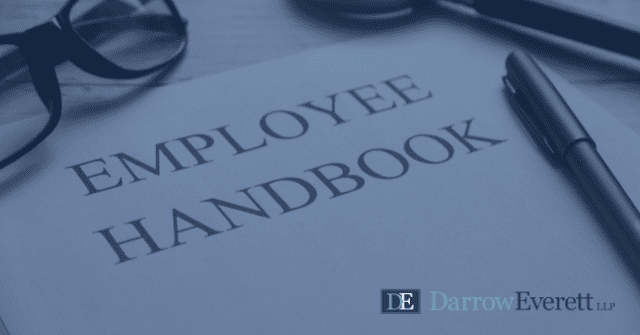
As we’ve said before, one of the easiest and least expensive tools for businesses to reduce liability and insulate from (at least some) risk, is often the one most frequently overlooked. Creating, promulgating, and most importantly enforcing an employee handbook is a simple and efficient way to communicate company policy and expectations to your employees and at the same time reduce your overall liability. In addition to drafting a good handbook, you also must stay continually vigilant for changes in statutes, regulations, and ordinances which may require revisions to your handbook.
While employee handbooks may not be required under law, there are many circumstances where a properly drafted handbook can provide tangible benefits (beyond employee satisfaction) and where a poorly drafted handbook can hurt you. One main goal of an employee handbook is to clearly document company policies and procedures, such as those covering harassment, employee safety, and disciplinary action so that employees both: (1) have a clear understanding of the rules; and (2) have assurance that all employees are treated in similar fashion. Another is to protect the company from liability by demonstrating the existence of clearly outlined and consistently enforced policies, as one of the first things that many agencies, whether it be the Equal Employment Opportunity Commission, a state fair employment practices agency, or the Department of Labor, will seek is your employee handbook. Most state agencies (or their federal counterparts) incorporate handbooks in their initial information requests to employers post-receipt of a complaint from an aggrieved employee. Additionally, handbooks are frequently referenced when responding to charges of discrimination. In essence, when crafted effectively, they not only offer employees transparent expectations but also demonstrate your company’s commitment to compliance.
What’s more, a properly drafted handbook has the potential to mitigate liability. In cases where an employee has filed a claim for harassment based on a hostile work environment, and the employer hasn’t taken any adverse action against the employee, the employer may be able to invoke what is commonly referred to as the Farragher-Ellerth defense.[1] This defense can help employers mitigate liability arising from the actions of staff who have acted improperly, provided the employer can demonstrate that they took reasonable steps to prevent and address harassing behavior, and that the employee unreasonably neglected opportunities provided by the employer to prevent or rectify the situation. In addition to general policies, individual states have their own requirements, available defenses, and pitfalls such as those found in the Tennessee Healthy Workplace Act and South Carolina’s conspicuous disclaimer law.
It is important to note that just as a well-written handbook can mitigate risk, an old or poorly written one can substantially increase risk. For example, the National Labor Relations Board (NLRB) has found certain provisions in handbooks to be unlawful, and handbooks that have not been revised in the last year run the risk of drawing the ire of the Board, which has substantially increased its penalties for noncompliance.
Evidencing this ever-fluid nature of employment and labor law, the NLRB issued a decision in Stericycle, Inc.[2], that created a new standard for the evaluation of workplace rules and handbooks. Stericycle overturns the previous Boeing Co.[3], standard which had been in place for approximately 13 years. The Stericycle ruling disregards the prior employer-employee interest balancing standard. Instead, the new standard now analyzes whether the rule or policy could reasonably be interpreted as chilling an employee’s exercise of Section 7 rights. If the rule meets that threshold, it is deemed presumptively unlawful no matter the existence of multiple interpretations. Further, instead of an actually reasonable individual, the new interpretation uses a “reasonable” employee who is economically dependent on the employer and is deemed to automatically interpret an ambiguous rule to prohibit protected activity. An employer may rebut these presumptions by showing that the policy advances a legitimate and substantial business interest that is not otherwise protectable through a narrower policy. Non-unionized employers should be mindful that NLRB rulings apply to all employers regardless of unionization status and that the NLRB has pursued non-union employers for unfair labor practices.
A well-crafted employee handbook can serve as a cost-effective and highly valuable resource to mitigate company liability. However, understanding the laws, regulations, and ordinances that may be relevant to your business at any given moment is crucial for creating and maintaining an effective handbook and steering clear of potential pitfalls. Additionally, given recent updates from the NLRB and elsewhere, it is prudent for businesses that already have employee handbooks in place to evaluate whether their existing policies would withstand scrutiny under these new interpretations, particularly policies related to employee discipline and confidentiality.
——————————————————————–
This DarrowEverett Insight should not be construed as legal advice or a legal opinion on any specific facts or circumstances. This Insight is not intended to create, and receipt of it does not constitute, a lawyer-client relationship. The contents are intended for general informational purposes only, and you are urged to consult your attorney concerning any particular situation and any specific legal question you may have. We are working diligently to remain well informed and up to date on information and advisements as they become available. As such, please reach out to us if you need help addressing any of the issues discussed in this Insight, or any other issues or concerns you may have relating to your business. We are ready to help guide you through these challenging times.
Unless expressly provided, this Insight does not constitute written tax advice as described in 31 C.F.R. §10, et seq. and is not intended or written by us to be used and/or relied on as written tax advice for any purpose including, without limitation, the marketing of any transaction addressed herein. Any U.S. federal tax advice rendered by DarrowEverett LLP shall be conspicuously labeled as such, shall include a discussion of all relevant facts and circumstances, as well as of any representations, statements, findings, or agreements (including projections, financial forecasts, or appraisals) upon which we rely, applicable to transactions discussed therein in compliance with 31 C.F.R. §10.37, shall relate the applicable law and authorities to the facts, and shall set forth any applicable limits on the use of such advice.
[1] See Burlington Indus., Inc. v. Ellerth, 524 U.S. 742, (1998); Faragher v. City of Boca Raton, 524 U.S. 775 (1998).
[2] Stericycle, Inc., 372 NLRB No. 113 (2023).
[3] Boeing Co., 365 NLRB No. 154 (2017).


